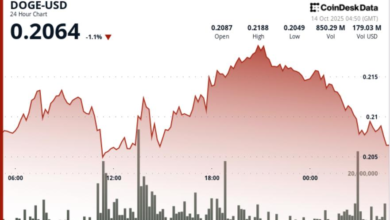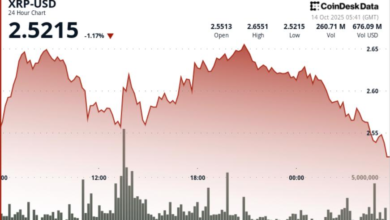Ripple-Linked XRP Echoes Bullish Bitcoin (BTC) Pattern

This is a daily technical analysis by CoinDesk analyst and Chartered Market Technician Omkar Godbole.
Imagine a ship caught in a fierce storm, battered by large waves and swaying wildly yet staying afloat. It indicates that beneath the turmoil, resilience persists, suggesting that smooth sailing will follow once the storm passes.
Similarly, when an asset’s price refuses to decline despite bearish signals from key indicators, it suggests underlying strength and a potential bull run ahead.
That’s the current situation in the XRP market and mirrors conditions in the bitcoin market that foreshadowed BTC’s historic run higher from $70,000 to $100,000 late last year. Let’s have a look at both.
XRP is the payments-focused cryptocurrency used by the Fintech company Ripple to facilitate cross-border transactions. The two, however, are not interchangeable.
XRP defies bearish MACD histogram
The underlying strength in XRP is evident from the way prices have been behaving relative to the MACD histogram in recent weeks.
The moving average convergence divergence (MACD) histogram is an exponential moving average (EMA)–based trend-following indicator widely tracked by both institutions and retail investors to identify price trends and measure trend momentum.
The MACD bars crossing from negative to positive indicate a bullish shift in momentum, suggesting the start of an uptrend in the asset’s price. A crossover below zero suggests otherwise, with consecutive deeper bars indicating a strengthening of the downward momentum.
XRP’s weekly chart MACD, used by traders to gauge long-term trends, crossed below zero in the first week of March, signaling a renewed downtrend.
However, a pronounced downtrend has not yet materialized, with prices mainly trading back and forth between $2 and $2.60, barring occasional short-lived dips below $2.

The divergence, marked by persistently bearish MACD and largely directionless trading, hints at bullish vibes or resilience beneath the surface – bulls successfully absorbing supply.
This prolonged divergence means the potential for a sudden bull revival and price increases. The bull case is supported by the upward-sloping 50-, 100- and 200-week simple moving averages (SMA).
BTC defied bearish MACD in 2024
The above-discussed divergence in XRP is similar to the conditions in BTC last year when the weekly MACD kept flashing red throughout the Summer. At the same time, BTC traded range-bound, barring occasional short-lived dips below $60,000.
CoinDesk noted the divergence in mid-September last year when BTC changed hands at around $59,000. Weeks later, BTC rose to $70,000, eventually topping the same in November to hit record highs above $100,000.
Let’s see if XRP follows the same path.




